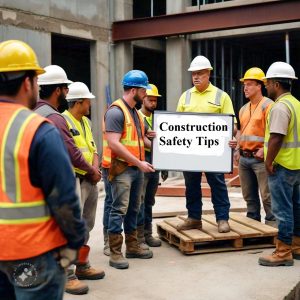Essential Construction Safety Tips Every Worker Should Know
Construction work is more than just putting up walls and laying foundations—it is about building the future. But as thrilling and rewarding as it is, construction is also one of the most hazardous industries, according to the Bureau of Labor Statistics. Whether you are a seasoned professional or just starting out as an intern, staying safe on the job is non-negotiable. Understanding and implementing construction safety practices is not just about following rules—it is about ensuring that everyone goes home safely at the end of the day. In this article, we will dive into the importance of construction safety, explore best practices, and break down what effective construction safety management looks like.

Importance of Construction Safety
Safety in construction is not just a checklist—it is a mindset that protects lives, livelihoods, and the future of every project. The construction industry sees a higher rate of workplace accidents and fatalities than most other industries, making safety a top priority. But beyond the obvious need to prevent injuries and fatalities, focusing on safety also makes good business sense. Safe worksites lead to fewer delays, lower insurance costs, and higher productivity. For construction workers, engineers, and safety professionals, prioritizing safety means taking responsibility for yourself, your team, and the project as a whole.
Overview of Construction Safety Best Practices
So, how do you ensure safety on a construction site? Ensuring safety on a construction site is not just about following rules—it is about creating a mindset where safety is the top priority. To build a truly safe work environment, everyone on site needs to be committed to best practices that minimize risk and protect both themselves and their colleagues. Let us break down some of the essential safety practices that should be at the heart of every construction project:
Fall Protection
Falls are one of the leading causes of injuries and fatalities in the construction industry. That’s why fall protection is crucial, especially when working at heights. Using harnesses, guardrails, and safety nets is not just a precaution—it is a necessity. Even if you are experienced with working at heights, the right fall protection can be the difference between a close call and a serious injury. Always ensure that your fall protection equipment is in good condition and that you are trained on how to use it properly.
Personal Protective Equipment (PPE)
Your last line of defense against workplace hazards is your PPE. Hard hats, gloves, safety glasses, safety vests, and steel-toed boots are not just suggestions—they are vital pieces of equipment that can protect you from common construction hazards. Whether you are dealing with falling objects, sharp materials, or flying debris, wearing the right gear significantly reduces the risk of injury. Make sure your PPE fits correctly and is appropriate for the specific tasks you are performing.
Site-Specific Safety Training
Every construction site is unique, with its own set of challenges and hazards. That is why site-specific safety training is so important. General safety training is a great foundation, but it is the site-specific details that ensure everyone knows how to stay safe in the specific environment they are working in. This might include understanding the layout of the site, knowing the location of emergency exits, or being aware of particular risks associated with the materials and equipment being used.
Effective Communication
Clear and consistent communication is the glue that holds safety practices together. Whether you’re using hand signals, radios, or daily briefings, making sure everyone is on the same page is essential. Good communication ensures that everyone on site is aware of potential hazards, knows what to do in case of an emergency, and can coordinate tasks without putting anyone at risk. Regular safety meetings and briefings keep safety at the forefront of everyone’s mind and encourage a culture where speaking up about safety concerns is the norm.
Regular Inspections and Maintenance
A safe construction site is a well-maintained one. Regular inspections of equipment and the worksite are critical for identifying and addressing potential hazards before they cause accidents. This means checking machinery for wear and tear, ensuring that safety barriers and warning signs are in place, and making sure that work areas are clean and free of unnecessary clutter. Preventive maintenance on tools and equipment not only keeps them running smoothly but also ensures they are safe to use.
Key Components of Effective Safety Management
Creating a safe construction site is not just about ticking boxes—it is about building a culture where safety is second nature. Effective construction safety management is the backbone of this culture, ensuring that every worker, from the newest intern to the most seasoned engineer, understands the importance of safety and how to maintain it. Let’s break down the key components that make a robust safety management system.
1. Risk Assessment and Hazard Identification
Before you even think about picking up a hammer or operating machinery, you need to know what you are dealing with. Risk assessment and hazard identification are the first steps in creating a safe work environment. This process involves a thorough examination of every aspect of the job—from the materials you will be using to the tools and equipment you will be handling. Imagine you are about to start a project. Before diving in, you take a moment to think through the possible dangers. Could that stack of bricks topple over? Is there a chance that operating the crane could bring you too close to overhead power lines? By identifying these hazards early on, you can put measures in place to prevent accidents. This might mean rerouting the crane or securing that stack of bricks more effectively. The goal is to anticipate risks before they turn into real problems, ensuring that everyone on site can work safely and confidently.
2. Safety Training and Education
Think of safety training as your toolkit for managing risks. It is not just a one-and-done deal—it is an ongoing process that evolves with every new project, technology, and team member. From the moment someone steps onto the site, they should be equipped with the knowledge they need to protect themselves and others. Initial training covers the basics, but it is the continuous education that really makes a difference. As construction methods and technologies evolve, so do the risks. Regular refresher courses keep everyone up to date on the latest safety protocols and best practices. Whether it’s a new piece of equipment or a new safety regulation, ongoing education ensures that workers are always prepared.
And let us not forget the importance of hands-on training. Theoretical knowledge is essential, but it is the practical application that drives the point home. Workers should regularly engage in drills and simulations that mimic real-life scenarios. This kind of proactive training not only builds competence but also boosts confidence, making it more likely that workers will respond effectively in the face of actual hazards.
3. Clear Safety Policies and Procedures
Every construction site needs a clear playbook—an unambiguous set of safety policies and procedures that everyone knows by heart. These are the rules of the game, and they are there for a reason. They spell out the right way to handle everything from PPE usage to emergency response, making sure that everyone on site is on the same page. But having policies and procedures is only half the battle. They need to be communicated clearly and consistently. This means more than just posting a sign in the break room. It means integrating safety into daily briefings, toolbox talks, and site inductions. When safety procedures are a regular part of the conversation, they become second nature to everyone involved. Moreover, enforcement is key. Policies and procedures should be followed rigorously, with regular checks to ensure compliance. This might involve periodic audits, spot checks, or even peer reviews, where workers hold each other accountable. The result is a work environment where safety isn’t just a set of rules—it’s a shared commitment.
4. Regular Safety Audits and Inspections
Safety is not static. It is an ongoing process that requires constant vigilance. That is where regular safety audits and inspections come in. These are the checkups that ensure everything is functioning as it should, and they are crucial for catching potential issues before they become serious problems. During an audit or inspection, every aspect of the site is scrutinized—from the condition of the equipment to the way materials are stored. Are the scaffolds secure? Are the fire extinguishers easily accessible and up to date? Is the site clean and free of obstructions? These inspections are a chance to identify hazards that might have been overlooked and to reinforce best practices.
But audits and inspections are not just about finding faults—they are also opportunities for continuous improvement. The feedback gathered from these processes can be used to refine safety protocols, making them more effective and easier to follow. It’s all about creating a safer, more efficient work environment, where everyone knows they’re protected.
5. Incident Reporting and Investigation
Accidents happen, even in the safest environments. When they do, it’s vital to learn from them. That is why incident reporting and investigation are critical components of effective safety management. The goal is not just to record what happened—it’s to understand why it happened and how to prevent it in the future.
When an incident occurs, it should be reported immediately, no matter how minor it may seem. This immediate reporting ensures that the details are fresh and accurate, which is crucial for the investigation process. The investigation should be thorough, looking not just at the immediate cause of the incident but also at any underlying factors that may have contributed.Was there a lapse in communication? Did a piece of equipment fail due to poor maintenance? Was there a gap in training? By asking these questions, you can uncover the root cause of the incident and take steps to address it. This might involve revising safety protocols, providing additional training, or upgrading equipment. The ultimate aim is to ensure that the same mistake doesn’t happen twice, making the site safer for everyone.
6. Worker Involvement and Communication
Safety is not just a top-down directive—it’s a team effort that involves every worker on the site. When workers are actively involved in safety management, they’re more likely to take ownership of their own safety and the safety of their peers. This involvement can take many forms, from participating in safety committees to leading toolbox talks.
Open communication is the cornerstone of worker involvement. Workers should feel comfortable speaking up about safety concerns without fear of reprisal. This kind of open dialogue encourages everyone to share their insights and experiences, leading to a more comprehensive understanding of the risks and how to manage them. Encouraging worker involvement also means recognizing and rewarding safe behaviors. When workers see that their commitment to safety is valued, they’re more likely to continue those behaviors and encourage others to do the same. It’s about creating a culture where safety is everyone’s responsibility, and where every worker is empowered to contribute to a safer work environment.
Final Thought.
Effective construction safety management isn’t just about following rules—it’s about creating a culture where safety is woven into the fabric of every project. By focusing on risk assessment, continuous training, clear policies, regular audits, thorough incident investigations, and active worker involvement, you can build a work environment where safety is prioritized by everyone. And in doing so, you’re not just protecting lives—you’re also ensuring the success and longevity of your projects.
Ready to stay on top of the latest in construction safety? Sign up for our newsletter to receive expert insights, tips, and updates delivered straight to your inbox. Together, we can build a safer future for the construction industry!




